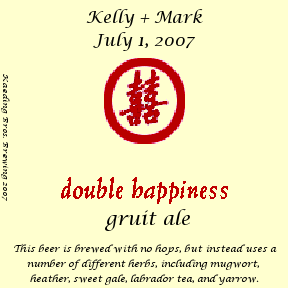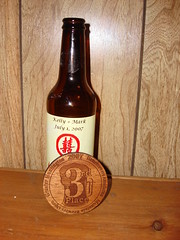In the first of (what I hope to be) many postings of my homebrew recipes, here is one of my favorites. It is my take on a traditional gruit-style ale. I am starting with this recipe partly because it turned out very well, even winning 3rd place in the 2007 Greater Huntington Homebrewers Association Mountain Brewers Open. Also, I imagine that a lot of people will be wanting to explore the gruit style, since it doesn’t use any hops (or, at least, my recipe doesn’t use any hops), and with the hops shortage, I know a lot of brewers are looking for alternatives.
I know what you might be thinking: “What self-respecting beer geek wants a beer with no hops?” Well, if that’s what you are thinking, then you really need to open your mind, and try this beer. I can’t stand the more-hops-is-always-better attitude, but thats a rant for another day. Lets get back on track.
[ad]
[amazon-product align=right]0937381667[/amazon-product]
I got interested in gruit after reading [amazon-product type=”text” text=”Sacred and Herbal Healing Beers: The Secrets of Ancient Fermentation”]0937381667[/amazon-product] by Stephen Harrod Buhner. It is a great book about fermented beverages made by indigenous societies throughout history. There is a good section in there about gruit, and some of the traditional ingredients used in it. I created my recipe myself, but most of my inspiration for this recipe came from this book. Historically, I guess this style all but disappeared around the time of the Protestant Reformation. Before that, the Church controlled the ‘gruit houses’, which supplied the herbs used in this style of brew. They had a monopoly on this, which gave them a great deal of power. As the power was shifting away from the church, laws like Reinheitsgebot were enacted outlawing the use of these ingredients in beer (I am not saying that this was the only reason for Reinheitsgebot; as with anything in history or politics, there were a number of factors at play). In fact, many of the ingredients used in gruit were thought to have intoxicating properties on their own. Some historians consider Reinheitsgebot to be one of the first drug-control laws.
I originally brewed this beer for my cousin Kelly. She has spent many years of her life in Asia, specifically China and Vietnam. She and her husband (then fiancé, obviously) chose the theme of ‘Double Happiness’ for their wedding, which I guess is traditional in that part of the world. I adopted the title for the beer I was brewing for the occasion. (As an aside, this was also my first experiment in making labels for my brew. What do you think?) My brother and I got together and brewed up 5 gallons of this for the barbecue on the day before the wedding. One cool thing I noticed at this barbecue was that the beer did not skunk. We were drinking it out or clear plastic cups in the sunlight, but there was no skunking. This isn’t really surprising, since the skunk aroma comes from compounds in hops reacting to sunlight (and there are no hops here), but it was cool.
You can probably find some of these ingredients at your local homebrew shop, or you can order them from Wild Weeds. I didn’t plan ahead enough, so I ended up dry-spicing with the stuff I got from Wild Weeds, and put what I could find at my local shop into the boil. If you switch this up, I’d love to hear how it comes out.
Double Happiness Gruit Ale Recipe (all grain)
On Brew Day
- 5 lb British 2 row
- 2 lb Crystal 60
- 1 lb Cara Red
- 1 lb Wildflower Honey
- 0.5 oz Mugwort (in boil for 45 mins)
- 1 oz heather tips (in boil for 45 mins)
- 0.5 oz Mugwort (in boil for 15 mins)
- 1 oz heather tips (in boil for 15 mins)
- 1 tsp Irish Moss (in boil for 15 mins)
- 2 gr sweet gale (added in hopback)
Starting gravity: 1.050
I mashed the grains as usual, and then added the honey in the beginning of the boil. The herbs were added as noted above.
When racking to secondary
- 2 oz Labrador Tea
- 2 oz Yarrow
Specific gravity at racking: 1.014
These herbs were added tot he secondary after racking, as if I were dry-hopping. Next time, I think I might tone back the Labrador Tea, since it was very dominant in the flavor profile.


18 Comments